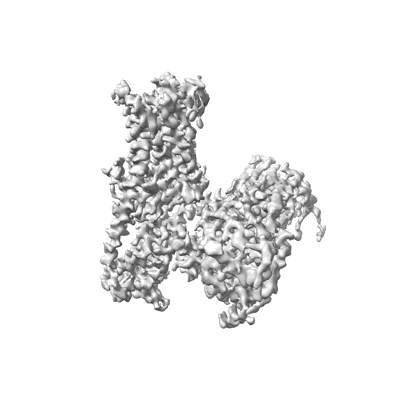EMD-36626
Ulotaront(SEP-363856)-bound Serotonin 1A (5-HT1A) receptor-Gi complex
EMD-36626
Single-particle3.65 Å
 Deposition: 20/06/2023
Deposition: 20/06/2023Map released: 15/11/2023
Last modified: 09/10/2024
Sample Organism:
Homo sapiens,
Mus musculus
Sample: hTAAR1-bound T1AM in complex with Gs heterotrimer
Fitted models: 8jsp (Avg. Q-score: 0.411)
Deposition Authors: Xu Z ,
Guo LL,
Zhao C
,
Guo LL,
Zhao C  ,
Shen SY,
Sun JP
,
Shen SY,
Sun JP  ,
Shao ZH,
Sun JP
,
Shao ZH,
Sun JP 
Sample: hTAAR1-bound T1AM in complex with Gs heterotrimer
Fitted models: 8jsp (Avg. Q-score: 0.411)
Deposition Authors: Xu Z
 ,
Guo LL,
Zhao C
,
Guo LL,
Zhao C  ,
Shen SY,
Sun JP
,
Shen SY,
Sun JP  ,
Shao ZH,
Sun JP
,
Shao ZH,
Sun JP 
Ligand recognition and G-protein coupling of trace amine receptor TAAR1.
Xu Z  ,
Guo L,
Yu J,
Shen S,
Wu C,
Zhang W,
Zhao C
,
Guo L,
Yu J,
Shen S,
Wu C,
Zhang W,
Zhao C  ,
Deng Y,
Tian X
,
Deng Y,
Tian X  ,
Feng Y
,
Feng Y  ,
Hou H,
Su L,
Wang H,
Guo S,
Wang H,
Wang K,
Chen P,
Zhao J,
Zhang X,
Yong X
,
Hou H,
Su L,
Wang H,
Guo S,
Wang H,
Wang K,
Chen P,
Zhao J,
Zhang X,
Yong X  ,
Cheng L,
Liu L,
Yang S
,
Cheng L,
Liu L,
Yang S  ,
Yang F
,
Yang F  ,
Wang X
,
Wang X  ,
Yu X
,
Yu X  ,
Xu Y
,
Xu Y  ,
Sun JP
,
Sun JP  ,
Yan W
,
Yan W  ,
Shao Z
,
Shao Z 
(2023) Nature , 624 , 672 - 681
 ,
Guo L,
Yu J,
Shen S,
Wu C,
Zhang W,
Zhao C
,
Guo L,
Yu J,
Shen S,
Wu C,
Zhang W,
Zhao C  ,
Deng Y,
Tian X
,
Deng Y,
Tian X  ,
Feng Y
,
Feng Y  ,
Hou H,
Su L,
Wang H,
Guo S,
Wang H,
Wang K,
Chen P,
Zhao J,
Zhang X,
Yong X
,
Hou H,
Su L,
Wang H,
Guo S,
Wang H,
Wang K,
Chen P,
Zhao J,
Zhang X,
Yong X  ,
Cheng L,
Liu L,
Yang S
,
Cheng L,
Liu L,
Yang S  ,
Yang F
,
Yang F  ,
Wang X
,
Wang X  ,
Yu X
,
Yu X  ,
Xu Y
,
Xu Y  ,
Sun JP
,
Sun JP  ,
Yan W
,
Yan W  ,
Shao Z
,
Shao Z 
(2023) Nature , 624 , 672 - 681
Abstract:
Trace-amine-associated receptors (TAARs), a group of biogenic amine receptors, have essential roles in neurological and metabolic homeostasis1. They recognize diverse endogenous trace amines and subsequently activate a range of G-protein-subtype signalling pathways2,3. Notably, TAAR1 has emerged as a promising therapeutic target for treating psychiatric disorders4,5. However, the molecular mechanisms underlying its ability to recognize different ligands remain largely unclear. Here we present nine cryo-electron microscopy structures, with eight showing human and mouse TAAR1 in a complex with an array of ligands, including the endogenous 3-iodothyronamine, two antipsychotic agents, the psychoactive drug amphetamine and two identified catecholamine agonists, and one showing 5-HT1AR in a complex with an antipsychotic agent. These structures reveal a rigid consensus binding motif in TAAR1 that binds to endogenous trace amine stimuli and two extended binding pockets that accommodate diverse chemotypes. Combined with mutational analysis, functional assays and molecular dynamic simulations, we elucidate the structural basis of drug polypharmacology and identify the species-specific differences between human and mouse TAAR1. Our study provides insights into the mechanism of ligand recognition and G-protein selectivity by TAAR1, which may help in the discovery of ligands or therapeutic strategies for neurological and metabolic disorders.
Trace-amine-associated receptors (TAARs), a group of biogenic amine receptors, have essential roles in neurological and metabolic homeostasis1. They recognize diverse endogenous trace amines and subsequently activate a range of G-protein-subtype signalling pathways2,3. Notably, TAAR1 has emerged as a promising therapeutic target for treating psychiatric disorders4,5. However, the molecular mechanisms underlying its ability to recognize different ligands remain largely unclear. Here we present nine cryo-electron microscopy structures, with eight showing human and mouse TAAR1 in a complex with an array of ligands, including the endogenous 3-iodothyronamine, two antipsychotic agents, the psychoactive drug amphetamine and two identified catecholamine agonists, and one showing 5-HT1AR in a complex with an antipsychotic agent. These structures reveal a rigid consensus binding motif in TAAR1 that binds to endogenous trace amine stimuli and two extended binding pockets that accommodate diverse chemotypes. Combined with mutational analysis, functional assays and molecular dynamic simulations, we elucidate the structural basis of drug polypharmacology and identify the species-specific differences between human and mouse TAAR1. Our study provides insights into the mechanism of ligand recognition and G-protein selectivity by TAAR1, which may help in the discovery of ligands or therapeutic strategies for neurological and metabolic disorders.
